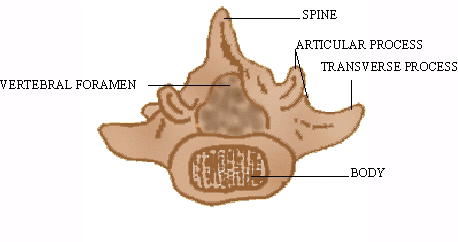|
PinkMonkey Online Study Guide-Biology
Lumbar Vertebra
(Fig. 20.10). (1) It has a big sized body with transverse measurement
more than antero-posterior axis. (2) No costal facets on body.
(3) No foramen transversarium. (4) Spine is thick, quadrangular
and projects backwards. (5) Vertebral foramen is triangular in
shape. (6) Transverse processes are thin and elongated in first
four, but strong and massive in fifth lumbar vertebra (Fig. 20.11).

Click Here To Enlarge
Figure 20.11 Fifth lumbar vertebra
iv) Sacrum (Fig. 20.12). (1) It is
a large triangular bone formed by the fusion of five sacral vertebrae,
and it lies obliquely in the pelvic cavity between two hip bones.
(2) It forms a sacro-vertebral angle’ (at 210 degrees) with
the rest of vertebral foramen. (3) The base is broad with
large, triangular vertebral column. The apex is narrow and blunt
with an oval facet for articulation with coccyx. (4) Transverse
process is broad with lateral mass and superior articular process.
(5) Shows four pairs of pelvic sacral foramina which
communicate with sacral element. (6) Dorsal surface is rough,
irregular and convex and faces backwards and upwards. It shows a
sacral hiatus i.e., an inverted ’V’ shaped gap or lower opening
of the sacral canal and sacral cornua on either side.
(7) Male sacrum is heavier, with marked muscular impressions
and is longer and broader compared to female sacrum.
[next page]
|
Table of Contents
20.0 -
Introduction
20.1 -
Axial Skeleton
20.2 -
Appendicular Skeleton
Chapter
21
|